Swansea University has, by using sections of tree trunk to limit carparking, created a wonderful substrate for the growth of fungi. Some populations are very impressive and extensive and one can certainly see masses of Sulphur tuft (Hypholoma fasciculare), Trooping Crumble cap (Coprinus disseminatus) and Coriolus versicolor brackets. More fungi were evident between Swansea and Mumbles. In that area, the flowers of Autumn are slow to go. Along with numerous Daisy, Dandelion, the odd Crucifer and Ragwort, Evening primrose (Oenothera spp), Bramble (Rubus fructicosus), Burnet rose (Rosa pampinellifolia), Sea rocket (Cakile maritima), Sea mayweed (Matricaria maritima) and Yarrow (Achillea millefolium) were still in flower. The first of the Winter heliotrope (Petasites fragrans) were, however, peeping though. Unremarkably, cultivated, foreign plants were also in bloom. At Blackpill, Oystercatchers (Haematopus ostralegus) massed on the beach.
This blog may help people explore some of the 'hidden' issues involved in certain media treatments of environmental and scientific issues. Using personal digital images, it's also intended to emphasise seasonal (and other) changes in natural history of the Swansea (South Wales) area. The material should help participants in field-based modules and people generally interested in the natural world. The views are wholly those of the author.
Subscribe to:
Post Comments (Atom)
Sandwich Island Saga 77. Common dung mushroom (Panaeolus antillarum)
After heavy rain in the Hawaii Kai garden.

-
I n the UK and US, a pparently popular and successful vegan/vegetarian restaurants are reportedly closing or adding meat to their menus ( ...
-
Early ripening fruit may seem convenient but some folk think it confirms environmental stress. There's also a possibility th...













%20mating%20NWCW.jpg)


No comments:
Post a Comment